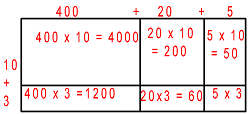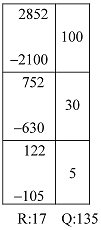CONTENT TYPE
SUBJECT
-
Number Sense
(17)
- Addition (8)
- Multiplication (32)
- Division (38)
- Fractions (73)
- Fractions Operations (68)
- Decimals (116)
- Read And Write Decimals (31)
-
Compare Decimals
(22)
-
Order Decimals
(10)
- Round Decimals (12)
-
Convert Decimals To Fractions
(5)
- Decimal Operations (40)
- Geometry (32)
- Measurement (24)
- Algebra (23)
- Word Problems (18)
-
VIEW DETAILS
 Word Form
Word FormChanging to Standard Form Game
In this exciting math game, kids will learn to change numbers to standard form by using their place value skills. They'll explore 5-digit numbers, focusing on place names to find the right answers. This game is perfect for enhancing number sense and understanding how to read and write large numbers. It's a fun way to practice important math skills!
-
VIEW DETAILS
 Expanded And Standard Form
Expanded And Standard FormChange Expanded to Standard Form Game
Kids can overcome misconceptions in math by playing this fun game that focuses on converting 5-digit numbers from expanded to standard form. Your child will engage with place value concepts and improve number sense while enjoying a balanced learning experience. Perfect for third graders, this game makes math both educational and entertaining!
-
VIEW DETAILS
 Word Form
Word FormChoose the Word That Fills the Blank Correctly Game
In this interactive game, kids will explore the world of multi-digit numbers by filling in the blanks with the correct words. They'll drag and drop items to solve fun problems, building confidence in place value and number sense. This engaging activity is perfect for young learners eager to master reading and writing multi-digit numbers.
-
VIEW DETAILS
 Expanded And Standard Form
Expanded And Standard FormIdentifying the Missing Number in Expanded Form Game
In this engaging game, kids will explore the concept of place value by identifying missing numbers in expanded forms. They'll tackle colorful challenges, enhancing their understanding of 5-digit numbers. With plenty of practice, students will apply their math knowledge to solve problems and improve their number sense. It's a fun way to learn and grow in math!
-
VIEW DETAILS
 Expanded And Standard Form
Expanded And Standard FormCompleting the Expanded Form of Whole Numbers Game
This fun math game helps kids understand place value by completing the expanded form of whole numbers. Students fill in blanks to solve problems, boosting their number sense and confidence. With regular practice, your fourth grader will excel in both classroom and real-world math challenges. A great way to learn and enjoy math!
-
VIEW DETAILS
 Place Value
Place ValueDecreasing the Number Game
In this exciting math game, kids will tackle problems that help them understand place value and number sense. By decreasing numbers, they'll learn to read and write multi-digit numbers with ease. This lively game is perfect for fourth graders looking to have fun while sharpening their math skills. Let the learning adventure begin!
-
VIEW DETAILS
 Place Value
Place ValueFilling the Number Present at the Mentioned Place Value Game
In this engaging game, students need to observe a given number and correctly fill in the digits at the mentioned place value. Kids will complete place value charts to solve problems, enhancing their number sense. Ideal for fourth graders, this game builds confidence in reading and writing multi-digit numbers. It's a fun learning journey in math!
-
VIEW DETAILS
 Place Value
Place ValueChoosing the Equivalent Value Based on Place Value Game
Join the adventure of choosing equivalent values based on place value! This engaging game helps kids tackle place value problems, enhancing their number sense. Perfect for young learners, it encourages interactive learning with multi-digit numbers, making math exciting and accessible. Watch your child grow confident in math with each challenge. Get started now!
Your one stop solution for all grade learning needs.
Give your child the passion and confidence to learn anything on their own fearlessly






















 and can be decomposed as
and can be decomposed as  . That is, as you go from right to left, the place value gets multiplied by 10. In other words, as you go from left to right, the place value gets divided by 10.
. That is, as you go from right to left, the place value gets multiplied by 10. In other words, as you go from left to right, the place value gets divided by 10. . The digit right to it has a place value of hundredth or
. The digit right to it has a place value of hundredth or  . Similarly, the right most digit, 8 has a place value thousandth or
. Similarly, the right most digit, 8 has a place value thousandth or  .
. .
.
 .
. .
.


 .
.







 and
and  , it is clear that 0.089 < 0.123 as
, it is clear that 0.089 < 0.123 as
 .
. . There are 4 hundreds, 2 tens, and 5 ones in 425. A multiplication by 3, would result in multiplying each component by 3.
. There are 4 hundreds, 2 tens, and 5 ones in 425. A multiplication by 3, would result in multiplying each component by 3.

 .
.



 .
. .
.

 and
and  which is a number less than the divisor. So, it is the remainder. This procedure can be tabulated as:
which is a number less than the divisor. So, it is the remainder. This procedure can be tabulated as:

 and can be shown by shading 3 parts of a square divided equally into 10 parts. Similarly, another decimal in tenths, 0.5 can be represented by shading 5 parts of a similar unit square divided equally into 10 parts. The addition of the two would result in shading 8 parts out of 10 which is equal to 0.8. Subtraction follows a similar procedure.
and can be shown by shading 3 parts of a square divided equally into 10 parts. Similarly, another decimal in tenths, 0.5 can be represented by shading 5 parts of a similar unit square divided equally into 10 parts. The addition of the two would result in shading 8 parts out of 10 which is equal to 0.8. Subtraction follows a similar procedure. and multiplying by 3 denotes adding it three times, resulting in
and multiplying by 3 denotes adding it three times, resulting in  or 0.75.
or 0.75.
 , we are trying to find how many groups of 1.2 is contained in 3.6. That is, we are trying to find a number, say n such that
, we are trying to find how many groups of 1.2 is contained in 3.6. That is, we are trying to find a number, say n such that  . Since kids are more comfortable working with whole numbers than decimals, we can consider the whole number version of this division as
. Since kids are more comfortable working with whole numbers than decimals, we can consider the whole number version of this division as  . That is, how many 12s are there in 36. We have:
. That is, how many 12s are there in 36. We have:





 .
.